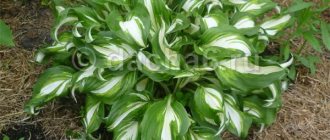What is daylily
Krasodnev, as this plant is also called, is part of the large Asphodelaceae family. The genus includes more than sixty thousand varieties and hybrids, differing from each other in the color of the petals and flowering time.
The perennial does not require care, but grows and blooms best in sunny areas with well-drained soils. Often gardeners use containers for planting, then placing them throughout the area.
You may be interested in:
What colors do daylilies go with in garden design? Daylilies are wonderful and not at all capricious flowers for the garden. In addition to the fact that they require a minimum...Read more...
Most of the hybrid forms and varieties are semi-evergreen and evergreen crops that retain the ability to grow throughout the entire calendar year. Therefore, it is necessary to carefully prepare the plantings for the winter cold. In the fall, it is necessary to carry out a number of activities: cut off the fading “arrows” of the plant’s leaves, treat them with anti-pest drugs. In regions where winters are harsh and there is a high probability of flowers freezing, daylilies provide shelter. They pay special attention to exotic hybrids of daylilies, whose homeland is warm overseas countries. In the conditions of the northern regions of Russia, they often do not survive winter, so it is better to grow simpler but frost-resistant varieties.
Preparing daylilies for winter
The plants are unpretentious, frost-resistant, but dependent on many external factors, including the correct agricultural technology. Daylilies cannot be left to their own devices; it is important to prepare them for wintering and minimize all risks.
Watering
If in summer daylilies are watered 1-2 times a week, then in autumn the plants usually do not need watering. Occasionally, the soil around the bushes is moistened, provided that there is no precipitation for a long time.
Feeding
Caring for daylilies in the fall includes feeding. Summer flowering takes a lot of energy; it is important for a perennial to restore its supply of nutrients before the cold weather.
Unlike spring fertilizing, when a full complex of all elements is applied, in the fall preference is given to potassium and phosphorus compositions. Potassium, in addition to promoting long-term lush flowering, increases the winter hardiness of crops. Daylily tolerates cold and temperature changes more easily, in the spring it adapts faster after cold weather and grows.
The introduction of phosphorus additives is effective: superphosphate, phosphate rock. The latter refers to fertilizers that require a long time to dissolve and be absorbed by plants. Therefore, the best time to apply such fertilizing is autumn, so that the plant meets spring full of strength.
Daylilies transplanted in the fall must also be fed. Phosphorus and potassium help plants quickly take root in a new place, undergo acclimatization and be ready for wintering. Thanks to them, the formation of flower buds is more active, the crop’s resistance to various infections and adverse weather factors increases, and the root system is strengthened and healed.
You may be interested in:
Preparing peonies for winter: pruning time Peonies are one of those species that do not need to be looked after particularly carefully during flowering. In the summer with…Read more…
Mineral supplements are often replaced with wood ash, which has a beneficial effect on the overall development of daylilies. It contains more than three dozen micro- and macroelements important for plants, which help increase the winter hardiness of the crop.
On a note!
It is allowed to use complex fertilizers that do not contain or have a small percentage of nitrogen.
Fertilizers are applied in liquid form under the bushes, strictly observing the standards specified in the instructions. The soil is slightly moistened so that the solutions do not burn the roots of the plants. Working compounds should not fall into the sheet socket
Replanting daylilies after flowering
After the daylilies have finished blooming (around August), it’s time to divide and replant them.
Interesting! Although daylilies are often replanted in the spring - in April.
How to divide and plant daylilies after flowering:
- Trim the foliage (or do it after planting).
In order for a plant to take root faster and better in a new place, it should not spend extra precious energy on green mass, so the above-ground part is always shortened.
- You dig up the bushes around the perimeter and take them out of the ground.
- Divide into several parts, usually 2-3 large or into separate sections.
- Choose a new place for planting (optimally sunny).
- Prepare the planting hole (mix garden soil with humus or compost, potash fertilizer, for example, potassium sulfate).
- Water, let the moisture absorb and place the division in the center of the hole.
- Fill it with soil, water it again, let it soak in, and add soil again.
Video: how to grow and propagate daylilies (divide and replant)
Preventive chemical treatment
In the fall, the plantings are treated with pest repellents, preventing them from being settled for the winter. Plants are threatened by:
- thrips;
- gall midge;
- nematodes;
- mole cricket;
- slugs and snails.
Cleaning and pruning help protect the daylily, but spraying is essential. Insects usually go down to the rhizomes for the winter, and only chemicals will help here.
For processing use:
- Decis;
- Aktellik;
- Aktar;
- Bi-58.
Working solutions are prepared according to the instructions, observing processing standards. To prevent daylily from becoming infected with diseases, copper-containing compounds (CHOM, Oksikhom), as well as Fitosporin or Discor are used.
On a note!
Not only the leaves of the plants are treated, but also the soil around the bushes is shed.
It is recommended to regularly disinfect agricultural equipment during the season (for example, with a bleach solution), including after completion of work before winter storage.
Pruning in autumn
After flowering ends, closer to cold weather, daylilies look untidy. The leaves of dormant varieties begin to dry out and die, and the flower stalks dry out. Due to rain and high humidity, rot often appears, which spreads to the root collar. This can be avoided by timely pruning. It is recommended to remove flower stalks immediately after flowering, and remove faded buds.
When is it better to prune in spring or autumn?
A debatable issue for flower growers, although it is resolved simply: it all depends on the state of the plantings, the climate of the area, the soil, and environmental conditions. Most experts recommend pruning daylilies in the fall, citing the following reasons:
- pruned plants are better protected from infections and pests;
- the risk of root collar rotting is minimized;
- In winter, pruned plants tolerate frost better;
- flower beds take on a neat, well-groomed appearance.
In spring, the crop begins to grow early, so cutting off daylilies at this time of year can seriously harm the plantings, slowing down their development and flowering time.
Best time to prune in autumn
The exact time to trim the aboveground part of the plant depends on the climate and weather conditions of the area. Experienced gardeners trim leaves when the first frost is predicted. The onset of a stable cold snap is a signal that it is time to prune the daylily, then the buds will not have time to “wake up” and get exposed to frost.
If you prune earlier, then before the cold weather the daylilies will begin to vegetate and produce new shoots, which will lead to the death of the plants.
Pruning technique
The pruning procedure is simple:
- Garden pruners are being prepared.
- Carefully cut off the leaves at a height of 12-15 cm.
- The cut leaves are removed and burned.
It is not recommended to place cut leaves in compost, as they may contain pests and infectious agents.
On a note!
You cannot cut the above-ground part flush with the soil surface. This will cause the growth of dormant buds and the plants will be exposed to frost.
Care after pruning
After harvesting cut and dried leaves and weeds, planting is left until cold weather. No work is carried out before the onset of winter.
Useful tips
The roots of daylilies are deep and branched, and their shoots are able to accumulate moisture in the pulp. Due to these features, the bush is not very demanding on moisture.
If autumn is dry, then daylilies must be watered 1-2 times a week. Watering is done in cloudy weather, in the morning or evening, with slightly warm water at the root. They stop when the first frost approaches.
Daylilies need to be trimmed so that small stumps remain on the surface. It is impossible to cut the leaves, stems and peduncles of daylilies too low (level with the soil level), as this provokes the growth of new green mass.
Fresh manure is not used in the autumn, since pathogenic fungi and microorganisms contained in it can cause rot and fungal diseases.
It is not recommended to use mown weeds as shelter for daylilies. Their seeds sprout around flowers in the spring and prevent plants from growing.
There are many tips for caring for and preparing daylilies for winter. Every gardener, having gained experience, draws up a whole plan of action so that these bright and beautiful flowers grow in his flower garden and delight them with blooming.
Autumn care and preparation of daylilies for winter does not cause difficulties even for novice gardeners. Having understood all the activities and carried them out according to the rules, in the spring the flowers quickly wake up and begin to develop and bloom.
Organization of winter shelter
Daylilies are considered a frost-resistant crop, but when caring, the characteristics of the variety or hybrid must be taken into account. In recent years, the climate has changed significantly; sudden thaws in the middle of winter are not uncommon even in Siberia and the North-West. And if this flower can withstand stable temperatures that are not particularly low, then changes, thaws, and then sharp frosts most often lead to the death of plants.
Do daylilies need to be covered for the winter?
In the south, this is not necessary, but in the regions of the middle zone, the North-West, Siberia, and the Urals, it is recommended to cover the plantings. This is especially true for areas where there are severe, prolonged frosts in winter with little snow.
How to properly cover daylilies for the winter
There is no complicated work involved in preparing perennials for winter. It is enough to prepare the required amount of spruce branches, peat or dry straw. Finely ground pine bark is suitable for mulching.
It is enough to sprinkle the plantings with a layer of mulch up to 10 cm thick. If serious frosts are expected in winter, the covering layer of daylilies for the winter is made thicker, and covering material is also used for additional protection.
Cover the plantings only with the onset of frost. Early covering in warm weather will lead to damping off of the plants; the same thing happens if you delay removing the protection in the spring.
Specifics of preparing daylilies for winter in the regions
In the conditions of different regions of Russia, flower growers take into account the peculiarities of the climate. It is also necessary to take into account the specifics of the variety: how it tolerates wintering, whether the plants need shelter.
In the middle lane
In the Moscow region and nearby areas, daylilies are covered with non-woven materials or mulch for the winter. Judging by the reviews of gardeners, the crop usually easily tolerates wintering even without shelter. But still, it’s not worth the risk, especially if the site contains southern hybrids from the American continent that are not accustomed to prolonged cold weather.
In the Volga region
In this region, daylilies need to be covered with spruce branches, bark, and peat. The mulch layer is at least 10-15 cm. In winter, monitor the snow cover over the plantings, adding snow if necessary to keep the plants warm.
In the Urals and Siberia
In the harsh conditions of these regions, it can be difficult for daylilies to survive the winter. Even well-covered plants (mulch, covering material, snow) can freeze out during prolonged frosts below 35 degrees.
Experienced flower growers usually carefully dig up rare species of daylilies along with a lump of earth and store them all winter in a basement or dry cellar. Another option: carefully dig up the rhizomes of the plants and place them in prepared soil or sand in the cellar. Regularly monitor the condition of the plants to prevent dryness or rot. In spring, the rhizomes are planted in their original place in the garden.
On a note!
Plants transplanted or planted in autumn must be covered for the winter, regardless of the region.
Why do you need to feed daylilies?
Plant nutrition comes first in agricultural technology. In daylilies, abundant flowering and normal stem formation are possible only with sufficient nutrition.
In ornamental gardening, hybrid forms with strong immunity are mainly used.
Attention! Daylilies rarely get sick; the only problem may be chlorosis.
All varieties of the crop are light-loving; full photosynthesis is possible only in an open area. Even if this biological requirement is met, the following picture can be observed:
- growth slows down;
- the stems become sparse and thin;
- leaves lose their brightness of color;
- the daylily looks weak in appearance;
- budding is defective, flowers die without opening;
- the size of the inflorescences is smaller or absent at all;
- The green mass begins to turn yellow and dry.
The main reason is a decrease in chlorophyll production, which occurs due to the fact that the daylily does not have enough nutrition. Feeding the plant is vital, but this does not mean that you can apply any means in unlimited quantities.
Important! Each stage of the growing season requires certain chemical elements.
Secrets and nuances of a successful winter
Knowledge of the intricacies of agricultural technology will help daylilies successfully survive the cold season.
- You should find out in advance as much information as possible about the varieties growing on the site. Everything is important: origin, frost resistance, flowering time.
- Mulch for shelters and special non-woven materials are prepared in advance so that the cold does not take you by surprise.
- Comply with the norms for applying fertilizers to flowers, excluding nitrogen-containing fertilizers.
- Daylilies are covered only when cold weather sets in, taking into account forecasts for the coming winter. A layer of mulch laid ahead of schedule will lead to the appearance of rot, damping off of the root system, and death of the perennial.
The main mistakes when caring for daylilies in the autumn
Despite the unpretentiousness of this beautiful perennial flower, it is important to follow the rules of agricultural technology. But even experienced flower growers do not always know how to care for and how to prepare daylilies for winter. Here are some errors:
- Application of fertilizing with nitrogen additives in the fall. The above-ground part begins to grow, which leads to weakening of the plant before wintering.
- Improper pruning of lush bushes. The leaves are cut at a height of no more than 15 cm, leaving a medium-length hemp. Low pruning leads to plant rotting and untimely bud growth.
- Early cover with mulch. The root system dies out, which leads to the death of flowers.
- Perennial pruning too early. In this case, in warm autumn, the plant produces leaves and grows actively, robbing the roots of the nutrients they need for wintering. You will have to prune the bush again, weakening the plant before winter.
- Densely cover the base of the bush, use heavy and wet mulch. Sawdust, spruce branches, straw must be dry, clean, free of debris and foreign objects.
Improper preparation leads to problematic wintering of plants, and in some cases to freezing and death of flowers.
The best time to plant daylilies on the site
Daylilies are peculiar long-livers. The most beautiful flowers, forming clumps decorated with multi-colored corollas, they can grow for up to one and a half decades without replanting. This should be taken into account when choosing a place for plants in the garden, and you should also know that flowering will be at its most lush only for 5–7 years. Then flower stalks appear less frequently among the dense foliage, and the flowers on them are much smaller than before. Therefore, every few years the plants are replanted, dividing the mature perennials.
The unpretentious culture easily tolerates this procedure from early spring to autumn. But planting daylilies in the ground in the spring always goes without complications, the divisions quickly take root and grow, blooming in the same season.
Spring weather is changeable, and if there is a danger of frost, it is better to postpone planting. Planting material purchased or obtained after dividing your own plants can be stored for about a month, burying the root system of the plant in sand, peat-sand substrate, or transferring it with a damp rag. The leaf blades of daylilies are cut by half or a third to reduce the plant’s need for moisture.
If the summer is not hot, and it is possible to create comfortable conditions for daylilies when planting them in the ground, as in spring, nothing prevents you from decorating the garden until the fall. But when planting in autumn, there is a risk that the plants will not have time to take root well, and next year, if they survive, they will be very weakened.











